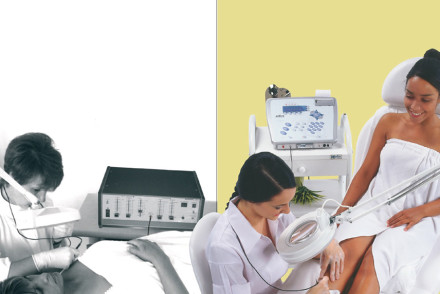Your body is changing, your belly is growing, and you can’t see your legs anymore. Shaving them has become a hassle and at this point, you may even have asked your partner’s help. On top of that, due to hormonal changes, you may notice unusual hair growth on different areas of your body, such as your chin, stomach or nipples. Hair removal methods, such as waxing and chemical depilatory creams, may now be more irritating and harmful to your sensitive skin. If you are a regular laser hair removal client, you may be advised to stop going to your salon as a safety precaution until you have breastfed your baby. So, what about electrolysis?
Which method to choose?
First of all, it is important to know the difference between the 3 methods available in electroepilation, namely electrolysis, thermolysis and combined current (Blend). Electrolysis uses a direct, unidirectional galvanic current that breaks down the water and salt in the hair follicle until they separate and create caustic soda. It is this substance that destroys the cells responsible for hair growth. This technique is no longer used today, as the application time was too long. Thermolysis uses a high frequency alternating current. This current creates heat in the atomic structure as the particles rub against each other. This concentrated heat destroys the cells responsible for hair growth. It is more popular than the other methods because its application time is very fast. Finally, the combined current, as its name suggests, combines galvanic current and thermolysis. This combination accelerates the caustic soda process. Its application time is still longer than thermolysis, but it is a very effective method in the case of curly and deformed hair.
Electrolysis and combined current are contraindicated during pregnancy. The galvanic current travels from the positive to the negative pole through the body, which could potentially reach the baby since the amniotic fluids that surround it could act as a conductor. Thermolysis is therefore the preferred procedure when you are pregnant, as its effect is localized only at the base of the hair.
When can I receive treatments and what areas can I treat?
Normally, during the first trimester, which is known to be a high-risk period for all pregnant women, it is advisable not to receive electrolysis treatments in order to keep stress levels to a minimum. If you decide to undergo treatment anyway, wait until after this trimester, talk to your doctor, and make sure, along with your electrologist, that she will only use thermolysis. In the third trimester, your skin will be tighter and more sensitive, so it’s best to avoid certain sensitive areas, such as the breasts and abdomen.
You will notice that during and after pregnancy, your breasts will be more sensitive than usual. If you plan to breastfeed your baby, avoid treatments on your breasts during this trimester and while you are breastfeeding. The most common and safest area to treat during pregnancy is the face.
Is electroepilation during pregnancy painful?
Although the skin may be a little more sensitive during pregnancy, electrolysis is a painless treatment. The sensation of the treatment is also more comfortable when the skin is well moisturized beforehand. If necessary, you can ask your electrologist to shorten the sessions. However, it is not recommended to use anesthetic creams during pregnancy, as their effects on the fetus have not been scientifically observed.
In conclusion, if you wish to have electrolysis during your pregnancy, your electrologist will always recommend that you seek medical advice and explain the important facts about electrolysis. The safest area to treat during pregnancy is undoubtedly the face. Also keep in mind that electrolysis has been around for over 100 years and there have been no reported cases of adverse effects on pregnant women. Therefore, if you have had excessive facial hair for some time and really want to get rid of it during your pregnancy, you can do so!








No Comments